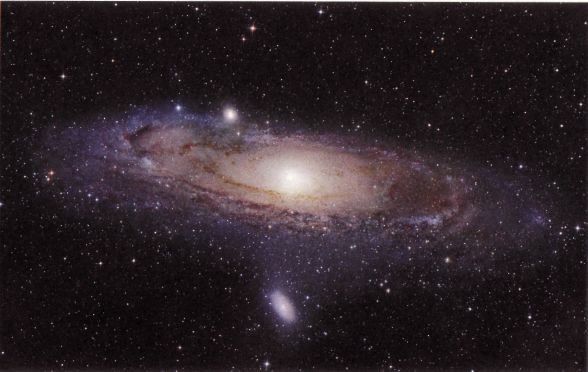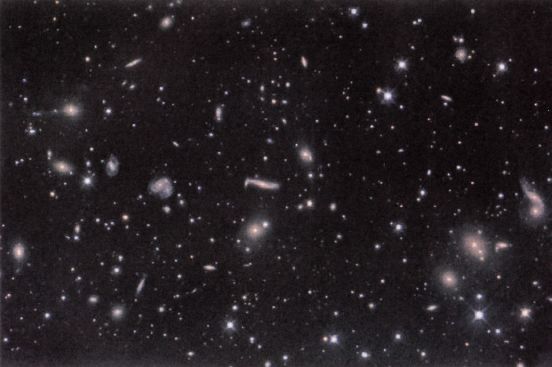This is the Pleiades, a set of young stars that have been born only recently and are still enveloped in their cocoons of interstellar gas and dust.
This is one of the many nebulae, large clouds of interstellar gas and dust. Just to be clear what we are seeing here, there is a sprinkling of foreground stars, behind which is a cloud of glowing interstellar hydrogen-that's the red stuff. The darkness is not the absence of stars; it is simply a place where the dark material prevents you from seeing the stars behind. It is in dense concentrations of this dark interstellar material that new stars and, we now are beginning to see, new planetary systems are in the process of being born.


This is a photograph of a dying star. In the course of its evolution, it has expelled its outer layers in a kind of bubble of expanding gas, mainly hydrogen. Stars do this episodically, possibly periodically, and when they do, grave problems are posed for any planets that are around such a star. This is hardly an unusual event for a star a little more massive than the Sun.
Here is a still more explosive and dangerous event. This is the Veil Nebula. It is a supernova remnant, a star that has violently exploded, and any life on any planet that existed around the star that exploded, the supernova, would surely have been destroyed in this explosion. Even ordinary stars like the Sun have a sequence of events late in their history, which mean big trouble for inhabitants of any planets that they might have.
Some 5 or 6 or 7 billion years from now, the Sun will become a red giant star and will engulf the orbits of Mercury and Venus and probably the Earth. The Earth then would be inside the Sun, and some of the problems that face us on this particular day will appear, by comparison, modest. On the other hand, since it is 5,000 or more million years away, it is not our most pressing problem. But it is something to bear in mind. It has theological implications.


There are a huge number of stars. Especially in the center of the galaxy, in the direction of the constellation Sagittarius, the sky is rippling with suns, altogether a couple of hundred thousand million suns, making up the Milky Way Galaxy. As far as we can tell, the average star is in no major way different from the Sun. Or, put another way, the Sun is a reasonably typical star in the Milky Way Galaxy, nothing to call our attention to it. If you had stepped a little bit back and included the Sun in this picture, you would not be able to tell whether it was that one right there or that one right over there, maybe, in the top right-hand corner.
It would be very good to have a photograph of the Milky Way Galaxy taken from an appropriate distance, but we have not yet sent cameras to that distance and so the best we can do for now is to show a photograph of a galaxy like our own, and this is, in fact, the nearest spiral galaxy like our own, M31 in the constellation Andromeda. And again we are looking at stars in the foreground within the Milky Way Galaxy, through which we are seeing M31 and two of its satellite galaxies.
Now, imagine that this is our galaxy. We are looking at a great concentration of stars in the center, so close together that we cannot make out individual ones. We see these spiral lanes of dark gas and dust in which star formation is mainly occurring. If this were the Milky Way Galaxy, where would the Sun be? Would it be in the center of the galaxy, where things are clearly important, or at least well lit? The answer is no. We would be somewhere out in the galactic boondocks, the extreme suburbs, where the action isn't. We are situated in a very unremarkable, unprepossessing location in this great Milky Way Galaxy But, of course, it is not the only galaxy. There are many galaxies, a very large number of galaxies.


This image is meant to convey just a little sense of how many. We are looking out of the plane of the Milky Way Galaxy in the direction of the Hercules Cluster. What we are seeing here are more galaxies beyond the Milky Way. (In fact, there are more galaxies in the universe than stars within the Milky Way Galaxy.) That is, there are some foreground stars as in the previous pictures, but most of the objects you see here are galaxies-spiral ones seen edge on, elliptical galaxies, and other forms. The number of external galaxies beyond the Milky Way is at least in the thousands of millions and perhaps in the hundreds of thousands of millions, each of which contains a number of stars more or less comparable to that in our own galaxy. So if you multiply out how many stars that means, it is some number-let's see, ten to the… It's something like one followed by twenty-three zeros, of which our Sun is but one. It is a useful calibration of our place in the universe. And this vast number of worlds, the enormous scale of the universe, in my view has been taken into account, even superficially, in virtually no religion, and especially no Western religions.
Now, I've not shown you images of our own tiny world, nor did Thomas Wright. He wrote, 'To what you have said about my having left out my own habitation in my scheme of the universe, having traveled so far into infinity as but to lose sight of the Earth, I think I may justly answer, as Aristotle did when Alexander, looking over a map of the world, inquired of him for the city of Macedon, 'tis said the philosopher told the prince that the place he sought was much too small to be there taken notice of and was not without sufficient reason omitted. The system of the Sun,' Wright goes on, 'compared but with a very minute part of the visible creation takes up so small a portion of the known universe that in a very finite view of the immensity of space I judged the seat of the Earth to be of very little consequence.'
This perspective provides a kind of calibration of where we are. I don't think it should be too discouraging. It is the reality of the universe we live in.
Many religions have attempted to make statues of their gods very large, and the idea, I suppose, is to make us feel small. But if that's their purpose, they can keep their paltry icons. We need only look up if we wish to feel small. It's after an exercise such as this that many people conclude that the religious sensibility is inevitable. Edward Young, in the eighteenth century, said, 'An undevout astronomer is mad,' from which I suppose it is essential that we all declare our devotion at risk of being adjudged mad. But devotion to what?
All that we have seen is something of a vast and intricate and lovely universe. There is no particular theological conclusion that comes out of an exercise such as the one we have just gone through. What is more, when we understand something of the astronomical dynamics, the evolution of worlds, we recognize that worlds are born and worlds die, they have lifetimes just as humans do, and therefore that there is a great deal of suffering and death in the cosmos if there is a great deal of life. For example, we've talked about stars in the late stages of their evolution. We've talked about supernova explosions. There are much vaster explosions. There are explosions at the centers of

